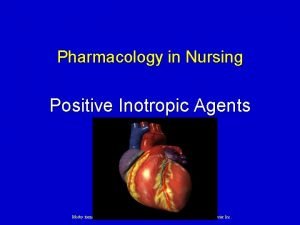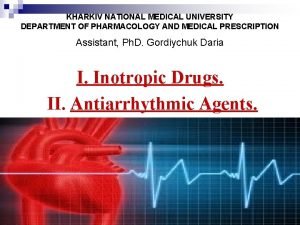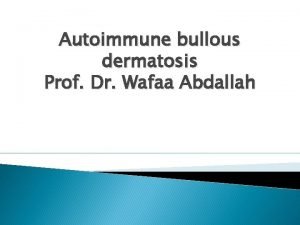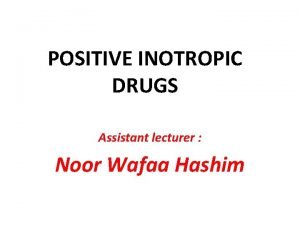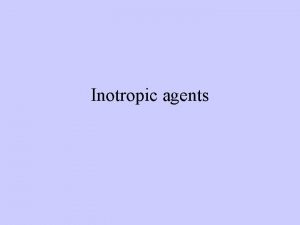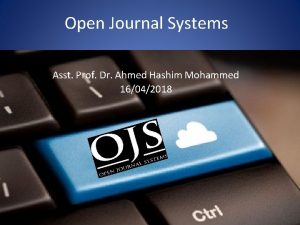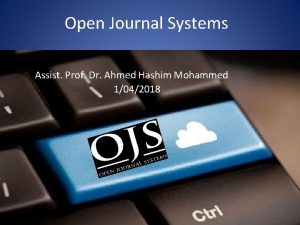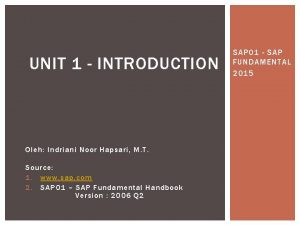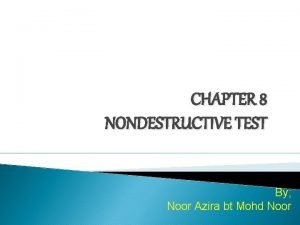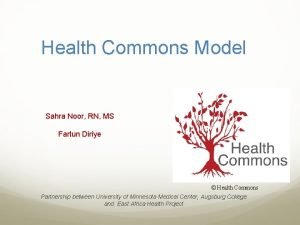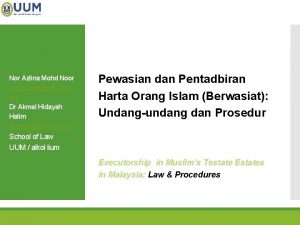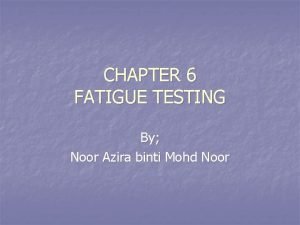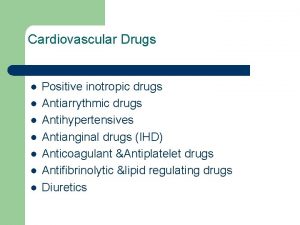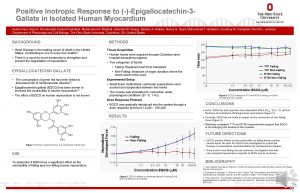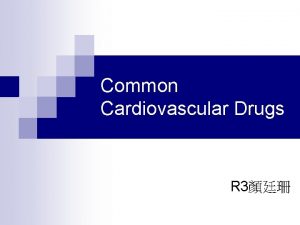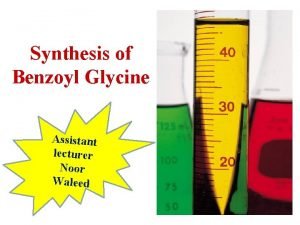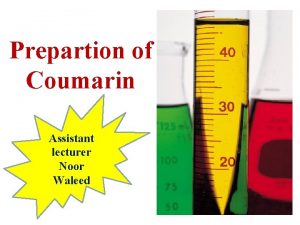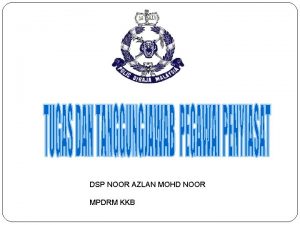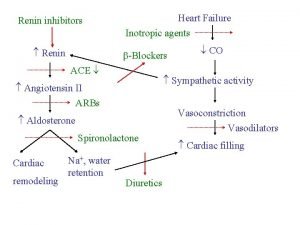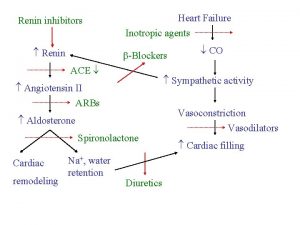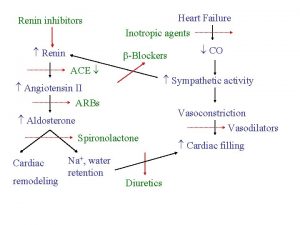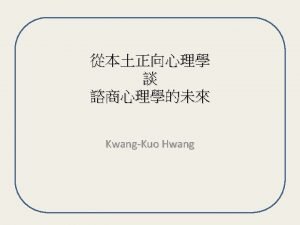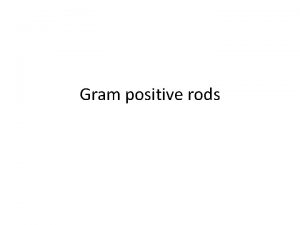POSITIVE INOTROPIC DRUGS Assistant lecturer Noor Wafaa Hashim








































- Slides: 40

POSITIVE INOTROPIC DRUGS Assistant lecturer : Noor Wafaa Hashim

Positive inotropic drugs 1. Cardiac glycosides : Digoxin. 2. +ve Inotropic sympathmimetics : Dopamine , Dobutamine.

Digoxin • Digoxin increase the force of myocardial contraction and reduce conductivity within the atrioventricular (AV) node. • In patients with heart failure who are in sinus rhythm, a satisfactory plasma digoxin concentration can be achieved over a period of about a week.

Clinical Use • Cardiac glycosides are most useful in the treatment of supraventricular tachycardia, especially for controlling ventricular response in persistent atrial fibrillation. • Digoxin is now rarely used for rapid control of heart rate even with intravenous administration, response may take many hours; persistence of tachycardia is therefore not an indication for exceeding the recommended dose.

Digoxin dosing • Digoxin has a long half-life and maintenance doses need to be given only once daily (although higher doses may be divided to avoid nausea). • The intramuscular route is not recommended. • Digitoxin also has a long half-life and maintenance doses need to be given only once daily or on alternate days

Digoxin dosing • Renal function is the most important determinant of digoxin dosage, whereas elimination of digitoxin depends on metabolism by the liver.

Digitalization • Rapid digitalisation, for atrial fibrillation or flutter, by mouth, 0. 75– 1. 5 mg over 24 hours in divided doses. Maintenance, for atrial fibrillation or flutter, by mouth, according to renal function and initial loading dose; usual range 125– 250 micrograms Daily. • Slow digitalisation , for heart failure (for patients in sinus rhythm), by mouth, 62. 5– 125 micrograms once daily.

Emergency loading dose • Emergency loading dose, for atrial fibrillation or flutter, by intravenous infusion (but rarely necessary), 0. 75– 1 mg over at least 2 hours , then maintenance dose by mouth on the following day. • Reduce dose by half with concurrent use of: amiodarone, dronedarone and quinine

Cautions • Cardiac glycosides should be used with special care in the elderly who may be particularly susceptible to digitalis toxicity. • Hypokalaemia predisposes the patient to digitalis toxicity; it is managed by giving potassium sparing diuretic or, if necessary, potassium supplementation.

Cautions • Hypercalcaemia (risk of digitalis toxicity). • hypokalaemia (risk of digitalis toxicity). • hypomagnesaemia (risk of digitalis toxicity). hypoxia (risk of digitalis toxicity). recent myocardial infarction. Severe respiratory disease. sick sinus syndrome. thyroid disease.

• PREGNANCY : May need dosage adjustment. • REBAST FEEDING : Amount too small to be harmful. • RENAL IMPAIRMENT: • Dose adjustments : Reduce dose. • Monitoring: Monitor plasma-digoxin concentration in renal impairment.

• Unwanted effects depend both on the concentration of the cardiac glycoside in the plasma and on the sensitivity of the conducting system or of the myocardium, which is often increased in heart disease. • It can sometimes be difficult to distinguish between toxic effects and clinical deterioration because symptoms of both are similar. Also, the plasma concentration alone cannot indicate toxicity reliably but the likelihood of toxicity increases progressively through the range 1. 5 to 3 micrograms/ litre for digoxin.

• Regular monitoring of plasma-digoxin concentration during maintenance treatment is not necessary unless problems are suspected. • Toxicity can often be managed by discontinuing digoxin; serious manifestations require urgent specialist management. • Digoxin-specific antibody fragments are available for reversal of life-threatening over dosage.

SIDE-EFFECTS: • Common or very common : Arrhythmias. cardiac conduction disorder. cerebral impairment. diarrhoea. dizziness . eosinophilia. nausea. skin reactions. vision disorders. vomiting. • INTERACTIONS → Appendix 1: digoxin

Digoxin tablets 125 mcg

Digoxin tablet 250 mcg

Digoxin Elixir 0, 05 mg/ml

Digoxin injection (250 mcg/ml)

Digoxin specific antibody fragments

Sympathomimetic agents Dopamine & Dobutamine

Dopamine hydrochloride • Dopamine is a cardiac stimulant which acts on beta 1 receptors in cardiac muscle , and increases contractility with little effect on rate.

INDICATIONS AND DOSE • Cardiogenic shock in infarction or cardiac surgery : ▶ BY INTRAVENOUS INFUSION: ▶ Adult: Initially 2– 5 micrograms/kg/minute

CONTRA-INDICATIONS : Phaeochromocytoma , tachyarrhythmia. • CAUTIONS : Correct hypervolemia. hypertension (may raise blood pressure). hyperthyroidism. low dose in shock due to acute myocardial infarction

SIDE-EFFECTS • Angina pectoris. anxiety. arrhythmias . azotaemia. cardiac conduction disorder. dyspnoea. gangrene. headache. hypertension . mydriasis. nausea. palpitations. piloerection . polyuria. tremor. vasoconstriction. vomiting

• PREGNANCY: No evidence of harm in animal studies—manufacturer advises use only if potential benefit outweighs risk. • BREAST FEEDING: May suppress lactation— not known to be harmful. • INTERACTION: see Appendix 1 in BNF (Sympathomimitics, inotropic)

DIRECTIONS FOR ADMINISTRATION • Dopamine concentrate for intravenous infusion to be diluted before use. • For intravenous infusion give continuously in Glucose 5%or Sodium chloride 0. 9%. • Dilute to max. concentration of 3. 2 mg/m. L; incompatible with bicarbonate.

MEDICINAL FORMS ▶ Dopamine hydrochloride (Non-proprietary) • Dopamine hydrochloride 40 mg per 1 ml Dopamine 200 mg/5 ml solution for infusion ampoules. • Dopamine hydrochloride 160 mg per 1 ml Dopamine 800 mg/5 ml solution for infusion ampoules.

Dopamine

Dopamine

Dobutamine • DRUG ACTION : Dobutamine is a cardiac stimulant which acts on beta 1 receptors in cardiac muscle, and increases contractility. • INDICATIONS AND DOSE: Inotropic support in infarction, cardiac surgery, cardiomyopathies, septic shock, cardiogenic shock, and during positive end expiratory pressure ventilation ▶ BY INTRAVENOUS INFUSION ▶ Adult: Usual dose 2. 5– 10 micrograms/kg/minute, adjusted according to response, alternatively 0. 5– 40 micrograms/kg/minute

• Cardiac stress testing: • ▶ BY INTRAVENOUS INFUSION • ▶ Adult: (consult product literature). • CONTRA-INDICATIONS: Phaeochromocytoma. • INTERACTIONS → Appendix 1: sympathomimetics, inotropic

CAUTIONS • Acute heart failure. acute myocardial infarction. arrhythmias. • correct hypercapnia before starting and during treatment. • correct hypovolaemia before starting and during treatment. • correct hypoxia before starting and during treatment. • correct metabolic acidosis before starting and during treatment. • diabetes mellitus. elderly.

CAUTIONS • extravasation may cause tissue necrosis. • extreme caution or avoid in marked obstruction of cardiac ejection (such as idiopathic hypertrophic subaortic stenosis). • hyperthyroidism. ischaemic heart disease. Occlusive vascular disease. severe hypotension. • susceptibility to angle-closure glaucoma. tachycardia. • tolerance may develop with continuous infusions longer than 72 hours.

SIDE-EFFECTS ▶ Common or very common : Arrhythmias bronchospasm. chest pain. dyspnoea. eosinophilia. fever. headache. inflammation localised. ischaemic heart disease. nausea . palpitations. platelet aggregation inhibition (on prolonged administration). skin reactions. Urinary urgency. vasoconstriction

• PREGNANCY : No evidence of harm in animal studies—manufacturers advise use only if potential benefit outweighs risk. • BREAST FEEDING : Manufacturers advise avoid —no information available. • MONITORING REQUIREMENTS : Monitor serum-potassium concentration.

• DIRECTIONS FOR ADMINISTRATION : Dobutamine injection should be diluted before use or given undiluted with syringe pump. • For intravenous infusion, give continuously in Glucose 5% or Sodium chloride 0. 9%. • Dilute to a concentration of 0. 5– 1 mg/m. L and give via an infusion pump; give higher concentration (max. 5 mg/m. L) through central venous catheter. • Incompatible with bicarbonate and other strong alkaline solutions

MEDICINAL FORMS • Solution for infusion • EXCIPIENTS: May contain Sulfites *Dobutamine (as Dobutamine hydrochloride) 5 mg per 1 ml Dobutamine 250 mg/50 ml solution for infusion vials. *Dobutamine (as Dobutamine hydrochloride) 12. 5 mg per 1 ml Dobutamine 250 mg/20 ml concentrate for solution for infusion ampoules

Dobutamine Vials 250 mg/20 ml

Dobutamine ampoules

Thank you
 Lecturer's name or lecturer name
Lecturer's name or lecturer name Negative chronotropic effect of digoxin
Negative chronotropic effect of digoxin Chronotropic
Chronotropic Wafaa abdallah
Wafaa abdallah How dr. wafaa elsadr epidemiology professor
How dr. wafaa elsadr epidemiology professor How dr. wafaa elsadr epidemiology professor
How dr. wafaa elsadr epidemiology professor Wafaa pronunciation
Wafaa pronunciation Inotropic agents
Inotropic agents Mohamed father in law
Mohamed father in law Dr mark hashim
Dr mark hashim Aweomar
Aweomar Dr ahmed hashim
Dr ahmed hashim Why is charlie telling hashim jokes?
Why is charlie telling hashim jokes? Hayder hashim md
Hayder hashim md Dr ahmed hashim
Dr ahmed hashim What is your favourite subject?
What is your favourite subject? Berniaga emas
Berniaga emas Boycott of banu hashim
Boycott of banu hashim Ahmed hasheem ebrahim
Ahmed hasheem ebrahim Why himalayan rivers are pernnial in nature
Why himalayan rivers are pernnial in nature Jeannie watkins
Jeannie watkins Lecturer asad ali
Lecturer asad ali Lecturer in charge
Lecturer in charge Lecturer name
Lecturer name Lector vs lecturer
Lector vs lecturer Spe distinguished lecturer
Spe distinguished lecturer Designation lecturer
Designation lecturer Lecturer in charge
Lecturer in charge Pearson lecturer resources
Pearson lecturer resources Good afternoon teacher.
Good afternoon teacher. Designation of lecturer
Designation of lecturer Cfa lecturer handbook
Cfa lecturer handbook 140000/120
140000/120 Photography lecturer
Photography lecturer Indriani noor hapsari
Indriani noor hapsari Noor azira bt basri
Noor azira bt basri Sahra noor
Sahra noor Ayu azlina md noor
Ayu azlina md noor Asbetose
Asbetose Rizwana noor
Rizwana noor Noor azira bt basri
Noor azira bt basri

